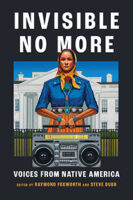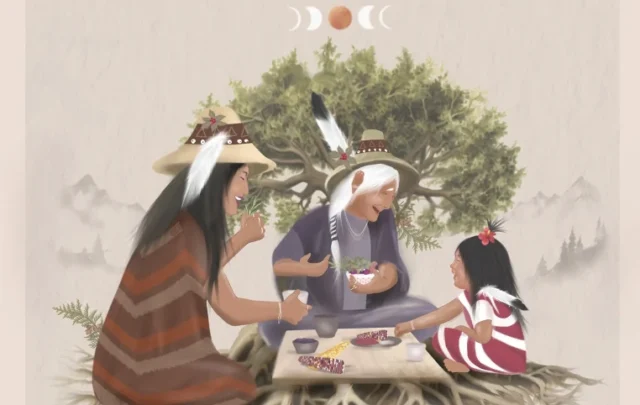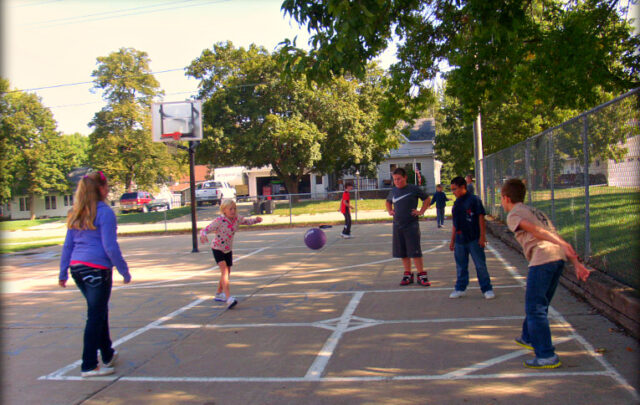 From Invisible No More: Voices From Native America edited by Raymond Foxworth and Steve Dubb. Copyright © 2023 First Nations Development Institute and The Nonprofit Quarterly. Reproduced by permission of Island Press, Washington, D.C. Chapter author: Hillary Renick. From Chapter 5: Fire, Forests, and Our Lands.
From Invisible No More: Voices From Native America edited by Raymond Foxworth and Steve Dubb. Copyright © 2023 First Nations Development Institute and The Nonprofit Quarterly. Reproduced by permission of Island Press, Washington, D.C. Chapter author: Hillary Renick. From Chapter 5: Fire, Forests, and Our Lands.
What Indigenous Peoples Know about Fire—and What We All Need to Know
Indigenous researchers of the past operated with a deep understanding of what today are acknowledged to be evidence-based practices for ecological sustainability. Indigenous cultures were full of people who were astute researchers and careful students of the ecological norms of their region. This included studies of disruptive forces such as fire, and how the landscape responded and changed over generations.10 This type of scientific and multigenerational knowledge was necessary to survive.
Through oral and written histories, many Indigenous societies amassed a wealth of knowledge, ranging from macro-ecological paradigms to individual micro-ecological processes.11 Examples of this type of knowledge could include macro- and mezzo-level understanding of changing landscapes,12 indicators of changes in seasons, ambient indicators of weather,13 macro- and mezzo-meteorological and wind patterns,14 processes and reactions of flora, animal and insect behavior, and again, the understanding of the role and need for disruptive forces and events such as fire.15
By utilizing their skills of observation, testing, and practice, many Indigenous cultures developed low-risk management practices to achieve the same effect as wildfire while minimizing the disruption to ecosystems that provided necessary resources.
One such method utilized by Indigenous societies in many different regions involved controlled, limited burning of forest, meadow, and prairie underbrush. Indigenous people became stewards of the land they inhabited because they observed how the health of the physical regional resources impacted all facets of culture;16 the food chain would be impacted by livable habitat. Available natural resources dictated economic practices and trade; there was also a psychosocial benefit of participating in an intergenerational practice that advanced social cohesion, connected living generations to their ancestors, and created a space for the next generations to inhabit.
Low-intensity burning of underbrush was observed by these Indigenous societies to be a beneficial means of controlling dangerous pests like ticks,17 encouraging useful brush crops like huckleberries,18 bolstering healthier crops of culturally significant plants such as basket-making material,19 and encouraging young shoots of grass to grow to help animals find food close enough for human hunters to sustain communities.20 Soil health—the ability of soil to hold water and nutrients—is fundamental to a vital ecosystem.
Western Science Belatedly Validates Indigenous Fire Ecology Knowledge
Initial explorers and immigrants who settled Indigenous land did not understand the complex interconnected landscape. For a long time, Western society chose to remain ignorant of the issues associated with otherwise unsustainable short-term ecological practices, policies, and actions—like suppressing naturally occurring fires.21 This mentality and the Western practice of fire suppression has contributed to human-accelerated climate change that threatens modern standards of life. Only with the development of recent rigorous and longitudinal climate studies has Western science begun to acknowledge that fire-based ecological practices, developed long ago by Indigenous practitioners, were perpetuating healthy natural cycles.22
Today, land management utilizing fire as a tool, reminiscent of Indigenous practices, is commonly incorporated into federal and state disaster-mitigation planning.23 Belatedly, these fire ecology practices are being seen by these agencies as part of the solution to help prevent the widespread destruction of natural and human resources.
Land managers, planners, and others now look toward such practices to design far-ranging solutions to help with areas devastated by wildland fires in the rural-urban interface. Of course, throughout the Western world, a form of ecological “catch-up” is being played. Western society’s failure to properly manage fire for the past century or more means that fire ecology efforts must confront the legacy of a century of fire ecology mismanagement,24 a challenge that has been greatly exacerbated by climate change. Today’s mass wildfires are part of this legacy of gross fire ecology mismanagement.
Chapter end notes:
- Jeff Mulhollem, “Eastern Forests Shaped More by Native Americans’ Burning than Climate Change,” Penn State (website), University Park, PA, May 21, 2019, https://www.psu.edu/news/research/story/eastern-forests-shaped-more-native-americans-burning-climate-change.
- Casey Kuhn, “‘Fire Is Medicine’: How Indigenous Practices Could Help Curb Wildfires,” PBS NewsHour, July 23, 2021, https://www.pbs.org/newshour/science/fire-is-medicine-how-indigenous-practices-could-help-curb-wildfires.
- Ecological Society of America, “Fire Ecology Manipulation by California Native Cultures,” ScienceDaily, July 26, 2014, www.sciencedaily.com/releases/2014/07/140726082324.htm.
- Mike Fletcher and Dick Whitaker, updated by Djarra Delaney, “Language, Culture, and Environmental Knowledge,” Indigenous Weather Knowledge, Australian Government, Bureau of Meteorology, Canberra, Australia, 2002 and 2015, http://www.bom.gov.au/iwk/culture.shtml.
- John Wright and Duane Johnson, Indigenous Knowledge and Cultural Weather Perspectives: Lessons to Support Science 10, Government of Saskatchewan, Regina, SK, 2007, https://www.stf.sk.ca/sites/default/files/unit-plans/s1063.pdf.
- National Geographic, “The Ecological Benefits of Fire,” National Geographic Resource Library, n.d., https://education.nationalgeographic.org/resource/ecological-benefits-fire.
- Rob Jordan, “Native Approaches to Fire Management Could Revitalize Communities, Stanford Researchers Find,” Stanford News, August 27, 2019, https://news.stanford.edu/2019/08/27/traditional-fire-management-help-revitalize-american-indian-cultures.
- Mejs Hasan, “Native Tribes Are Taking Fire Control into Their Own Hands,” Wired, August 9, 2018, https://www.wired.com/story/wildfires-native-tribes-controlled-burns.
- United States Forest Service, “Gifford Pinchot National Forest Huckleberries,” US Department of Agriculture, Vancouver, WA, n.d., https://www.fs.usda.gov/detail/giffordpinchot/passes-permits/forestproducts?cid=fsbdev3_005071.
- Kari Marie Norgaard and Sara Worl, “What Western States Can Learn from Native American Wildfire Management Strategies,” The Conversation, October 29, 2019, https://theconversation.com/what-western-states-can-learn-from-native-american-wildfire-management-strategies-120731. See also: Emily Buhrow Rogers and Carolyn Smith, “Weaving through Time, Pandemic, and Wildfire,” Smithsonian Center for Folklife and Cultural Heritage Magazine, March 22, 2021. https://folklife.si.edu/magazine/crisis-carolyn-smith-weaving-pandemic-wildfire.
- Northwestern University, “Prescribed Fires Help Native Plants Find Mates, Reproduce, and Flourish: Study,” Phys.org, January 27, 2020, https://phys.org/news/2020-01-native-flourish.html.
- Kirk Siegler, “Why Suppressing Wildfires May Be Making the Western Fire Crisis Worse,” NPR Morning Edition, August 27, 2022, https://www.npr.org/2022/08/27/1119428879/why-suppressing-wildfires-may-be-making-the-western-fire-crisis-worse
- Jazmin “Sunny” Murphy, “How Indigenous Knowledge Reconnects Us All to Fire,” Yes! magazine, September 20, 2022, https://www.yesmagazine.org/environment/2022/09/20/fire-indigenous-traditional-ecological-knowledge.
- Priya Shukla, “What California Stands to Learn from Indigenous Fire Management Practices,” Forbes, October 28, 2019, https://www.forbes.com/sites/priyashukla/2019/10/28/what-california-stands-to-learn-from-indigenous-fire-management-practices.
- Yvette Cabrera, “Wildfires Are Getting Worse and So Is the Deadly Smoke They Bring with Them,” Grist, December 16, 2019, https://grist.org/justice/wildfiresare-getting-worse-and-so-is-the-deadly-smoke-they-bring-with-them.





